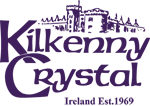History
Kilkenny Crystal was Ireland's pioneer in handcrafting lead crystal glassware from a small studio workshop. Nowhere in Ireland is there a similar workshop of comparable expertise & variety of skills. In the late sixties Paddy Clancy, a native of Callan Co. Kilkenny, with his keen interest in crafts, started to look at crystal with a view to starting his own glass workshop. During 1969 he met Hans Gross, a German-born master craftsman. Hans had vast experience in the crystal industry, and had worked in Germany, Sweden, England, before coming to Ireland. Paddy was building a new home, and decided to use the large garage for Kilkenny Crystal's humble beginnings. As a result new equipment was purchased and the workshop started to take shape. Hans then started to train our first apprentice, Tommy Roche. Later Bridget, a sister of Tommy, joined the firm and also worked in the production area. During our early years every piece was hand-polished, as was all cut glass or crystal prior to 1920. Hand-polishing involves following the cuts with a cork or wooden wheel with damp pumice powder as an abrasive. The pumice left a polished but dull finish to the cuts, and so a brush or horsehair wheel with a specific yellow powder was used to achieve the desired sparkling finish. Because hand-polishing became rare once chemicals to polish were developed in 1920 our early hand-polished pieces are today collector's items. Kilkenny is the only crystal company in Ireland to have hand-polished its production & have experience in this area. Polishing completely by hand is so very slow that we were obliged to move to the chemical polishing process in 1977, but to this day we still incorporate the hand polishing process in our production. In the early 1970s a book on Irish Glass devoted a full chapter to Kilkenny Crystal, its history and products, as our designs were very different from all the other crystal available in Ireland at that time. A son & daughter of Paddy later joined the firm, Richard in 1985, who manages the production at our workshops in Callan, and Mary in 1994, who manages the retail end of the business. Just 8 years after the first pieces were produced we moved to a larger building adjacent to the original workshop. In addition to our Factory Shop in Callan we also opened an outlet in 1987 at 19 Rose Inn Street, in the heart of Kilkenny City. Today the crystal is still cut by hand, using the traditional methods, and to the same high standards set in the early years. Kilkenny Crystal is the oldest family-owned & run crystal workshop in Ireland. You will find our products in the Vatican, The White House and homes all over the world. A SHORT HISTORY OF GLASS IN IRELAND One of the first known glasshouses in Ireland was in Drumfenning Woods just west of Dungarvan founded about 1590. Kilkenny's earliest known glasshouse is "The Gurteens Glasshouse", in south County Kilkenny 1729-1740. In 1746 an Act of the English Parliament banned the import of any glass into Ireland except English glass and the export of any glass from Ireland. It was not until 1780 that these restrictions were relaxed, enabling the industry to flourish. Factories opened at Waterford and Cork in 1783, and others soon followed in Dublin. In 1825 an Excise Tax was levied on glass by weight and from that year the manufacture of Irish glass appears to have declined. In 1845 the duty was lifted on all glass made in Ireland, but by that time the damage was done and some Irish glasshouses had already ceased production. The factory at Waterford ceased production in 1851, Belfast continued in production until 1868, with the last remaining factory in Dublin closing in 1893. Between the late 1800s & 1951 no cut glass was produced in Ireland. Waterford Crystal was started in 1951. In the late 1960s crystal factories also started in Galway, Dublin and Kilkenny. HISTORY OF GLASS Sand, or silica, is the main ingredient of glass. Soda is added to bring down the melting point, and lime is needed to make the glass hard and durable. The story goes that a group of Phoenician sailors, while camped on a beach, lit a fire and set their cooking pots on blocks of natron (soda), which was the cargo they were carrying. When they awoke the next morning they found that the heat of the fire had fused the sand and soda into glass. Blowing glass was discovered in the third quarter of the 1st century BC, in the Middle East. The Venetian industry dominated the European glass-making industry between 1400 and 1700. In the 17th century came the development of new glass recipes in Germany and England. Germany's potash-lime glass was thicker and harder and suited wheel-engraved decoration. In 1675, an Englishman called George Ravenscroft was one of the first to add lead oxide, this formula became the basis of lead crystal and meant that lenses, microscopes and telescopes became possible. During the 18th century the strength of European glass-making moved from Venice to Bohemia, Germany, France, England, Ireland, and a number of other countries. Cutting, although an ancient technique, only became really popular when steam powered lathes could be used to drive the cutting wheel. Obviously today glass-cutting lathes are powered by electricity.


